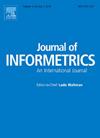Journal internationalization of non-English-speaking countries: Indicator framework design and influencing factor analysis
IF 3.5
2区 管理学
Q2 COMPUTER SCIENCE, INTERDISCIPLINARY APPLICATIONS
引用次数: 0
Abstract
English is widely recognized as the predominant lingua franca in the global scientific community, in such context many non-English-speaking countries have started to establish their own English-language scientific journals, so as to enhance academic influence and promote international collaboration. Despite the inherent nature of English-language scientific journals in non-English-speaking countries is facilitating transnational knowledge exchange, current mainstream evaluation metrics (such as Journal Impact Factor) fail to assess this characteristic objectively. To fill this gap, our study analyzed 3,077 English-language journals from 17 non-English-speaking countries, using data from the Journal Citation Report (JCR) and InCites to evaluate journal internationalization degree (JID) across three levels: journal-level (Level 1), paper-level (Level 2), and citation-level (Level 3). Results show that JID varies across countries and does not necessarily exhibit consistency at different levels. At country level, correlation analyses revealed that Human Development Index (HDI) positively relates to all levels of JID, while English Proficiency Index (EPI) only affects the proportion of non-domestic papers. At the journal level, we examine the effects of open access (OA), article processing charges (APC), and Category Normalized Citation Impact (CNCI) on JID. The findings show that while OA modestly enhances international visibility, higher APCs negatively impact international submissions. Among these factors, CNCI emerges as the strongest driver of global reach, showing a strong correlation with both international submissions and citations. Potentially, our research can provide insights for journals to adjust their development strategies and advance their internationalization process.
非英语国家期刊国际化:指标框架设计与影响因素分析
英语在全球科学界被广泛认为是主要的通用语,在这种背景下,许多非英语国家开始建立自己的英语科学期刊,以提高学术影响力,促进国际合作。尽管非英语国家的英语科学期刊具有促进跨国知识交流的固有性质,但目前主流的评价指标(如期刊影响因子)未能客观地评价这一特点。为了填补这一空白,本研究分析了来自17个非英语国家的3,077种英语期刊,使用期刊引文报告(JCR)和InCites的数据来评估期刊国际化程度(JID)在三个层面:期刊水平(1级)、论文水平(2级)和引文水平(3级)。结果表明,JID在不同国家存在差异,在不同水平上不一定表现出一致性。在国家层面上,相关分析显示人类发展指数(HDI)与JID的各个水平呈正相关,而英语水平指数(EPI)仅影响非本国论文的比例。在期刊层面,我们考察了开放获取(OA)、文章处理费(APC)和类别标准化引文影响(CNCI)对JID的影响。研究结果表明,虽然OA适度提高了国际知名度,但较高的apc对国际提交产生了负面影响。在这些因素中,CNCI成为全球影响力最强的驱动力,与国际提交和引用都表现出很强的相关性。研究结果可为期刊调整发展策略、推进国际化进程提供参考。
本文章由计算机程序翻译,如有差异,请以英文原文为准。
求助全文
约1分钟内获得全文
求助全文
来源期刊

Journal of Informetrics
Social Sciences-Library and Information Sciences
CiteScore
6.40
自引率
16.20%
发文量
95
期刊介绍:
Journal of Informetrics (JOI) publishes rigorous high-quality research on quantitative aspects of information science. The main focus of the journal is on topics in bibliometrics, scientometrics, webometrics, patentometrics, altmetrics and research evaluation. Contributions studying informetric problems using methods from other quantitative fields, such as mathematics, statistics, computer science, economics and econometrics, and network science, are especially encouraged. JOI publishes both theoretical and empirical work. In general, case studies, for instance a bibliometric analysis focusing on a specific research field or a specific country, are not considered suitable for publication in JOI, unless they contain innovative methodological elements.
 求助内容:
求助内容: 应助结果提醒方式:
应助结果提醒方式:


